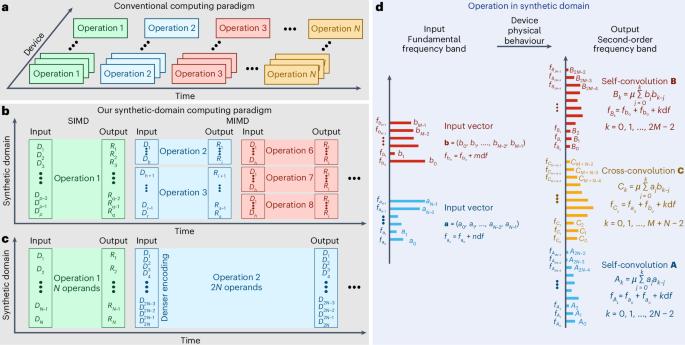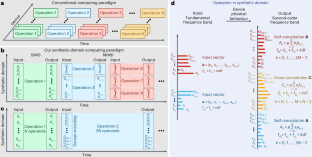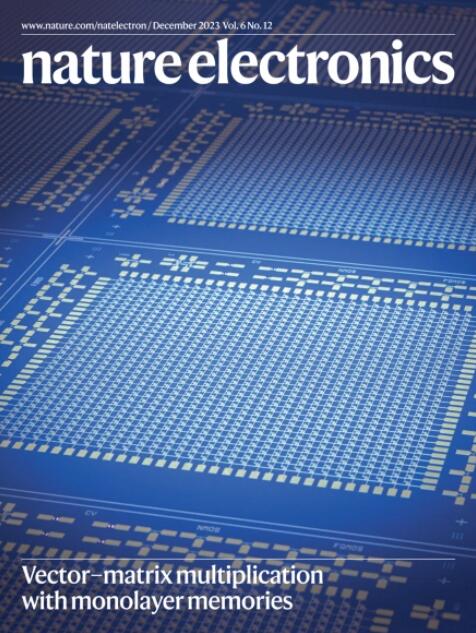Synthetic-domain computing and neural networks using lithium niobate integrated nonlinear phononics
IF 40.9
1区 工程技术
Q1 ENGINEERING, ELECTRICAL & ELECTRONIC
引用次数: 0
Abstract
Analogue computing uses the physical behaviours of devices to provide energy-efficient arithmetic operations. However, scaling up analogue computing platforms by simply increasing the number of devices leads to challenges such as device-to-device variation. Here we report scalable analogue computing and neural networks in the synthetic frequency domain using an integrated nonlinear phononic platform on lithium niobate. This synthetic-domain computing is robust to device variations, as vectors and matrices are concurrently encoded at different frequencies within a single device, achieving a high throughput per area. Leveraging inherent nonlinearities, our device-aware neural network can perform a four-class classification task with an accuracy of 98.2%. The nonlinear phononic computing hardware also maintains consistent performance over a wide operational temperature range (characterized up to 192 °C). Our synthetic-domain computing combines single-device parallelism, inherent nonlinearity and environmental stability, and could be of use in edge computing applications in which power efficiency and environmental resilience are crucial. By encoding vectors and matrices at different frequencies within a single device, a device-aware neural network based on lithium niobate integrated nonlinear phononics can be created that can perform a four-class classification task with an accuracy of 98.2%.


基于铌酸锂集成非线性声道的合成域计算和神经网络
模拟计算利用设备的物理行为来提供节能的算术运算。然而,通过简单地增加设备数量来扩展模拟计算平台会导致设备到设备变化等挑战。在这里,我们报告了可扩展的模拟计算和神经网络在合成频域使用集成的非线性声子平台铌酸锂。这种合成域计算对设备变化具有鲁棒性,因为向量和矩阵在单个设备内以不同的频率同时编码,从而实现了每个区域的高吞吐量。利用固有的非线性,我们的设备感知神经网络可以以98.2%的准确率执行四类分类任务。非线性声子计算硬件在宽工作温度范围内(特征为高达192°C)也保持一致的性能。我们的合成域计算结合了单设备并行性、固有非线性和环境稳定性,可用于功率效率和环境弹性至关重要的边缘计算应用。
本文章由计算机程序翻译,如有差异,请以英文原文为准。
求助全文
约1分钟内获得全文
求助全文
来源期刊

Nature Electronics
Engineering-Electrical and Electronic Engineering
CiteScore
47.50
自引率
2.30%
发文量
159
期刊介绍:
Nature Electronics is a comprehensive journal that publishes both fundamental and applied research in the field of electronics. It encompasses a wide range of topics, including the study of new phenomena and devices, the design and construction of electronic circuits, and the practical applications of electronics. In addition, the journal explores the commercial and industrial aspects of electronics research.
The primary focus of Nature Electronics is on the development of technology and its potential impact on society. The journal incorporates the contributions of scientists, engineers, and industry professionals, offering a platform for their research findings. Moreover, Nature Electronics provides insightful commentary, thorough reviews, and analysis of the key issues that shape the field, as well as the technologies that are reshaping society.
Like all journals within the prestigious Nature brand, Nature Electronics upholds the highest standards of quality. It maintains a dedicated team of professional editors and follows a fair and rigorous peer-review process. The journal also ensures impeccable copy-editing and production, enabling swift publication. Additionally, Nature Electronics prides itself on its editorial independence, ensuring unbiased and impartial reporting.
In summary, Nature Electronics is a leading journal that publishes cutting-edge research in electronics. With its multidisciplinary approach and commitment to excellence, the journal serves as a valuable resource for scientists, engineers, and industry professionals seeking to stay at the forefront of advancements in the field.
 求助内容:
求助内容: 应助结果提醒方式:
应助结果提醒方式:


